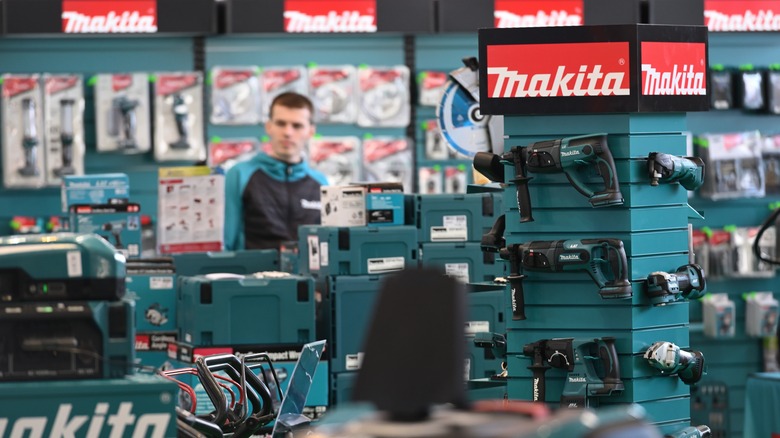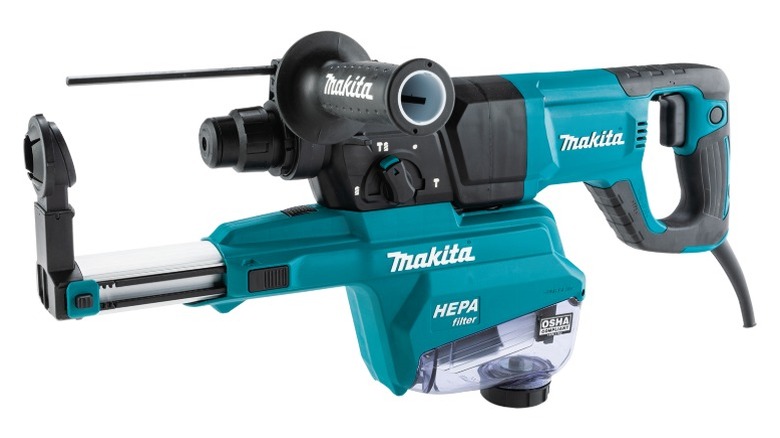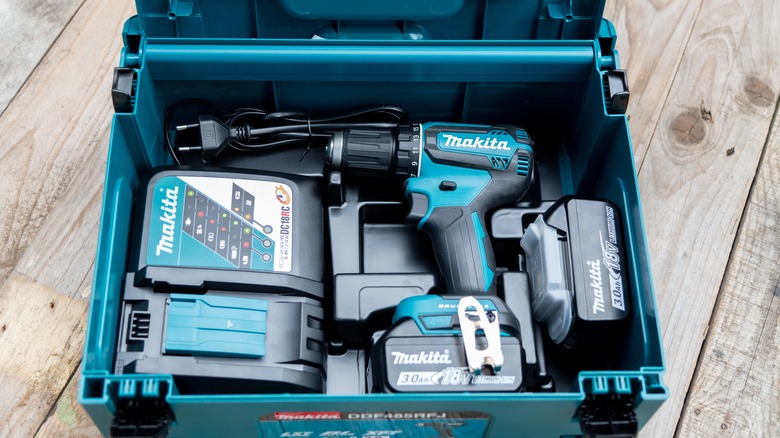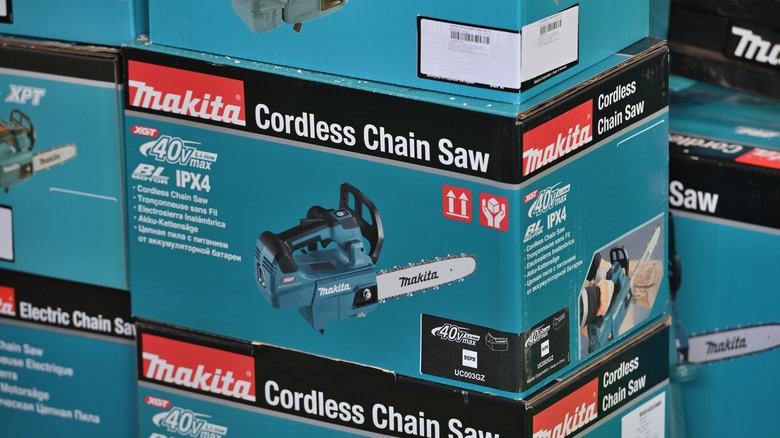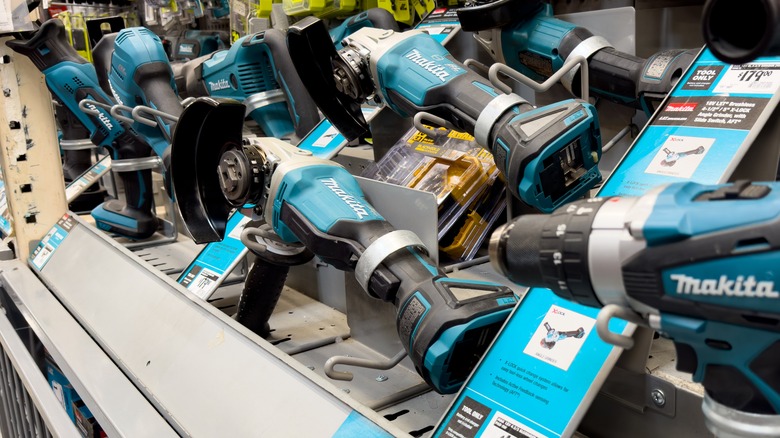5 Technologies Exclusively Found On Makita Tools
Makita Tools has a long history in the power tool industry, having been in operation since 1915, no small feat for a tool company. Over the past century or so, the Japanese company has built a reputation for crafting tough and reliable gear that professionals and weekend DIYers alike keep going back to. Sure, good quality and availability of cheap Makita power tools help, but what really keeps Makita in the game is how it pushes the envelope with new tech.
Instead of sticking to the basics or jumping on bandwagons, Makita has, over the years, come up with a handful of innovations you won't find in rival brands' offerings. Some of these are small details you might not notice unless you're looking really hard and have compared Makita's products against those from its rivals. Conversely, some innovations have become big selling points that help Makita stand out in the crowded power tools market. From longer-lasting batteries to anti-vibration systems, here are five of the coolest technologies you will only find on Makita power tools.
Advanced AVT (Anti-Vibration Technology)
If you've used a rotary hammer for more than a few minutes, you know the pain that comes from its constant vibration. It doesn't just make your hands uncomfortable; it can cause fatigue, numbness, and even long-term issues if you're using the tool daily. To address this, the company came up with AVT or Anti-Vibration Technology. Instead of relying on just a padded grip, a mechanical counterbalance system inside the tool works to reduce vibrations before they can reach your hands. According to Makita, this reduced vibration effectively makes the tool more powerful.
Makita also has an updated version of the tech it calls Advanced AVT. This version comes with three main components: an air-actuated counterbalance, vibration-absorbing housing, and an integrated damper spring. All three work together to really absorb vibration without affecting the performance and power of the device. The air-actuated counterbalance moves in the opposite direction to the drive piston, canceling out some of the natural vibration caused by moving parts. Meanwhile, the rear and side handles are mounted in a vibration-absorbing housing, so you're not directly holding onto the shaking components. Finally, the built-in damper spring absorbs the sharpest impacts from drill bits or chisels.
LXT lithium-ion battery system
Introduced in 2005, Makita's LXT battery platform was one of the earliest 18V lithium-ion systems to hit the market, and it arguably changed the cordless tool game. Today, it remains the backbone of Makita's cordless lineup, powering over 350 products, including many of the 18V Makita tools users recommend the most. This means that whether you are buying a simple drill, a blower, or a circular saw from Makita, you will likely rely on LXT batteries to power your device.
The biggest advantage Makita's LXT Lithium-ion battery system brings is flexibility. Instead of using different batteries for tools with different power needs, LXT will let you utilize the same type of battery to power all of them. For instance, you can pair two 18V batteries to run a 36V tool. This means you don't need to buy into a whole separate platform just to power a larger saw or other high-demand equipment. The batteries themselves also come in different sizes, from 2.0Ah for lightweight jobs to 6.0Ah for maximum runtime.
Makita pairs these batteries with charging systems and motors that are tuned to get the most out of them. The result is longer run times, more power, and faster charging compared to many competing brands. For DIYers, this means you'll always have enough juice for your projects. For professionals, it means less downtime and fewer batteries cluttering up the worksite.
XGT battery system
While LXT covers most needs, Makita might have realized that some jobs demand more serious muscle. That's why it came up with its XGT battery system, one of the several types of batteries Makita sells in the U.S. This newer battery technology is built around a 40V system. While that doesn't sound like a big jump over LXT's 36V option at first glance, XGT's edge is that you can double up on batteries to create an 80V power source. That's enough to run heavy-duty cordless tools that would normally be stuck with a power cord or even a gas engine. We're talking about tools like demolition hammers, power cutters, and other job site beasts.
With Makita's XGT technology, you can bring that kind of power to a cordless setup without losing the convenience and flexibility. The batteries come in 2.5Ah, 4.0Ah, and 5.0Ah sizes, giving you options depending on whether you want more runtime or less weight. One of the smartest parts of XGT is that it's designed to live alongside LXT, not replace it. The chargers are compatible with both systems, so you don't need to deal with a pile of mismatched docks and cords. This newer battery technology is not quite as widely used as LXT, but it does power tools like the highly-recommended Makita brushless impact driver and circular saw, among others.
STAR Protection Computer Controls
Many people do not realize how much tech goes into a modern power tool. It's not just a motor spinning a bit anymore. Instead, there's a whole communication system linking the battery and the tool itself, and Makita's STAR Protection Computer Controls are a perfect example. STAR is a built-in monitoring system that watches both the tools and the batteries for three major issues: overloading, overheating, and over-discharging. If it detects one of these issues, it will shut the tool down automatically to prevent damage.
Though this may sound annoying, this function is actually a lifesaver, especially for novice users who may not yet know the particularities of their Makita tools. Instead of burning out your drill's motor or killing your battery, STAR Protection gives you a chance to reset, swap batteries, or let your tool cool down before continuing. This Makita-exclusive tech also extends the life of both tools and batteries. You'll know your Makita tool and battery have this technology when you see a STAR symbol on their label.
XPT (Extreme Protection Technology)
Job sites aren't exactly clean environments. Between dust, dirt, and unexpected water or rain, tools take a beating almost all the time. While most manufacturers try to toughen up their gear with rugged housings, Makita equips its tools with XPT or Extreme Protection Technology. XPT is basically a system of seals built into each tool's casing. These seals are designed to keep water and dust away from the internal components, protecting the motor and electronics inside.
However, this doesn't mean the tools are waterproof, so you can't dunk a drill in a bucket to test this out. What this means is that you can keep working in the rain, on muddy ground, or in a dusty workshop without worrying about your XPT-equipped tools failing. For outdoor workers, landscapers, or anyone who uses tools in unpredictable or harsh conditions, this feature is a huge advantage. Even in a regular garage setting, XPT can help extend the life of Makita power tools by keeping fine sawdust or dirt from building up inside.
